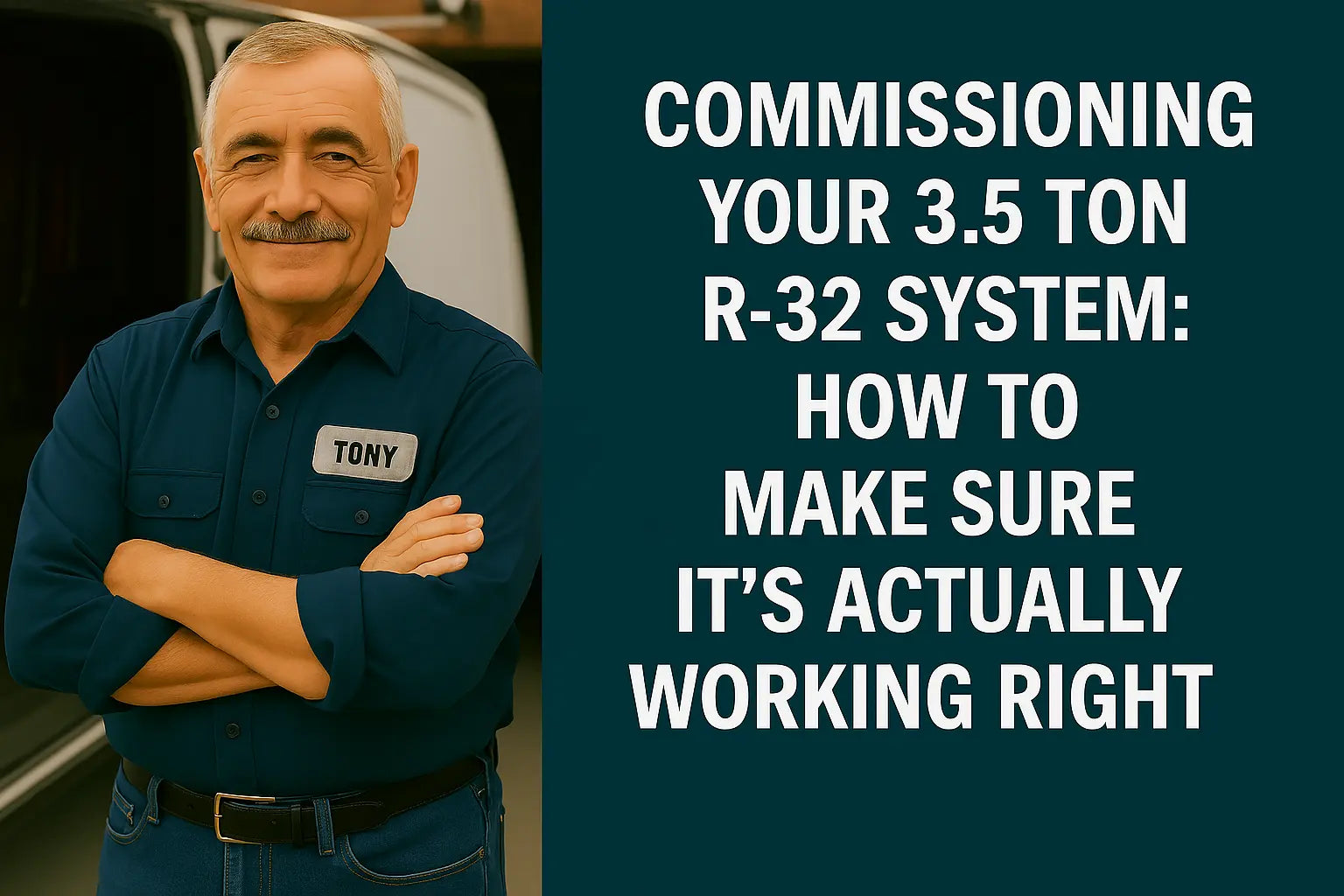Hey There—Tony Again.
And today, we’re talking about something most folks skip until it’s too late: commissioning.
You just installed a shiny new 3.5-ton R-32 AC and gas furnace system—maybe one of those energy-efficient bundles from The Furnace Outlet. It’s piped in, wired up, and blowing air...
But is it actually working right?
Because let me tell you: if you don’t test it, you’re guessing. And when it comes to R-32 systems and modern furnaces, guessing can cost you airflow, efficiency, and a whole lot of callbacks.
Let’s walk through Tony’s no-nonsense startup checklist to make sure that 3.5-ton beast is ready to roll.
Step 1: Confirm Model Match & System Setup 🧾
Before you even flip the breaker:
-
Double-check your indoor and outdoor unit pairing (condenser, coil, furnace, and thermostat must match capacity and refrigerant type)
-
Verify the furnace is rated for your altitude and gas type
-
Confirm line set length and charge line diameter follow Goodman’s R-32 guidelines (R-32 has different pressure and oil requirements than R-410A!)
Need the official reference? Goodman’s technical support library has every install spec, charge chart, and accessory guide you’ll ever need.
Step 2: Airflow Check (The Foundation of Everything) 🌬️📏
A 3.5-ton system should deliver about 1,400 CFM. If airflow isn’t right, everything else—charge, temp split, combustion—gets thrown off.
Here’s how to verify:
-
Measure static pressure with a manometer
-
Calculate airflow with a fan chart or TrueFlow Grid
-
Target 0.4"–0.5" total external static pressure
-
Inspect for duct leaks, crushed flex, and dirty filters
Airflow low? Stop now and fix it first. Bryant Lincoln does a great job explaining how airflow makes or breaks HVAC systems.
Step 3: Blower Configuration 🔧
Now that airflow’s good, make sure the blower speed matches the tonnage. This is where a lot of DIYers (and even some techs) get lazy.
For a Goodman furnace:
-
Use the blower tap chart in the manual
-
Select proper speed using DIP switches or control board jumper settings
-
On ECM motors, confirm CFM settings match your 3.5-ton requirement (1,400 CFM target)
If you skip this step, expect high head pressure, warm coil temps, poor dehumidification—and angry homeowners 😤
Step 4: Gas Furnace Commissioning 🔥
Now for the heat side. Whether you’ve got an 80% or 96% AFUE model, here’s what to check:
-
Manifold gas pressure: Use a manometer; typically 3.5" WC for natural gas
-
Temperature rise: Should match nameplate (usually 35–65°F)
-
Combustion analysis: Use a digital analyzer to check CO, O₂, and flue temp
-
Clock the meter: Make sure the furnace is actually pulling the rated BTUs
Need help with combustion testing? HVAC School’s how-to guide will walk you through every step.
Step 5: R-32 Refrigerant Charging Protocol ❄️📉
This one’s crucial. R-32 is a single-component, high-pressure refrigerant, and it’s not as forgiving as older blends.
Here’s what to do:
-
Verify factory charge is appropriate for your line set length
-
Run system for at least 15 minutes under load
-
Measure subcooling (target: 8–12°F depending on chart)
-
Use liquid line charging only—and always weigh your charge in
Don’t forget: overcharging can create flash gas at the metering device, while undercharging leads to coil freeze and poor cooling.
Building Engines has a great write-up on subcooling vs. superheat methods for modern systems.
Step 6: Temperature Split Verification 🌡️
With the system running, take your supply and return temps.
Goal is:
-
18°F–22°F split in cooling mode
-
35°F–65°F split in heating mode (verify against furnace nameplate)
Too low = undercharge or airflow issue
Too high = dirty coil, overcharge, or duct restriction
Use a fast-read digital probe, not a meat thermometer from the kitchen drawer 🙃
Step 7: Safety Control Check 🚨
Before you call the job done, test every limit, switch, and control:
-
Flame rollout switches (manual reset)
-
Pressure switches (block off condensate drain to test)
-
High limit switch (simulate overheat)
-
Door switch
-
Condensate overflow float
All safeties should cut power to the appropriate component when tripped. No exceptions.
Step 8: Documentation & Owner Walkthrough 🗂️🏡
Don’t just high-five yourself and disappear. Take five more minutes and do this:
-
Record:
-
Model/serials
-
Static pressure
-
Temp splits
-
Subcooling
-
Gas pressure
-
-
Label filters, drain lines, and disconnect
-
Teach the homeowner how to change the filter and operate the stat
-
Set a reminder for first filter check and coil cleaning
This last step builds trust and protects your warranty—and it’s what separates pros from “Chuck in a Truck.”
Tony’s Final Words 👨🔧📣
Let me tell you straight: a 3.5-ton R-32 AC and gas furnace system isn’t something you just “plug in and hope.” These high-efficiency systems demand respect—from airflow to gas pressure to refrigerant charge. If you skip commissioning or fudge the numbers, you’re setting yourself up for a hot house, high bills, or worse… a burned-out compressor.
Want it to:
-
Run quietly?
-
Deliver even comfort?
-
Hit those SEER2 efficiency numbers?
-
Keep running clean for 15 to 20 years?
Then commission it the right way—the first time.
And if you’re working with one of the factory-direct bundles from The Furnace Outlet’s 3.5-Ton R-32 AC and Gas Furnace Collection, follow this checklist to the letter. These systems are built to perform, but only if they’re installed and started up like they should be.
Test it. Log it. Confirm it’s dialed in.
Because trust me—nothing’s worse than getting that callback two weeks later:
“Hey, it’s running… but it doesn’t feel right.”
So do yourself a favor: commission it like a pro. You’ll sleep better knowing it’s right.
Want more maintenance tips? Visit my guide: How to Maintain Your 3.5-Ton R-32 System for 20 Years of Trouble-Free Comfort.
Catch you on the next job,
—Tony the Trusted Tech







